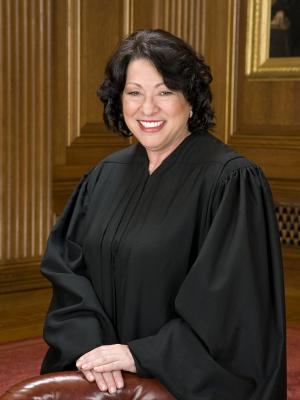
Sotomayor was born in the Bronx on June 25, 1954 to Juan Sotomayor and Celina Baez, both native Puerto Ricans. Her father worked in manual labor and her mother was a nurse. The family took residence in the Bronxdale Houses, one of the most coveted complexes in the city-owned housing projects. Sotomayor’s father passed away when she was nine. Following his death, Celina began working six-day weeks as a nurse to support the family, and Sonia learned to speak English fluently. Celina managed to send her children to private Catholic school. Sotomayor decided to become an attorney at the age of 10 upon watching an episode from the legal drama "Perry Mason." With this goal in mind, she studied diligently while attending Cardinal Spellman High School. Through self-enforced discipline, Sotomayor graduated valedictorian of her class in 1972.
Her early success earned her a scholarship to study at Princeton University. She joined student groups selectively, but did not hesitate once committed. When serving as co-chairman of the Puerto Rican activist group Acción Puertorriqueña, she accused the Princeton administration of discriminating against Puerto Ricans in hiring. In support of this work for Puerto Rican rights, she crafted an impressive senior thesis on the life of the famed Puerto Rican Luis Muñoz Marín. In 1976, Sotomayor graduated summa cum laude with her bachelor's degree in history, gaining election into Phi Beta Kappa along the way. At Yale she began to display the thought processes that would shape her legal mind. She published a noteworthy article on Puerto Rico's right to offshore minerals and was known for always making persuasive arguments. She co-chaired the Latin American and Native American Students Association and worked as an editor for the Yale Law Journal.
The legendary Manhattan district attorney Robert Morgenthau hired 25-year-old Sotomayor to work in his office following her graduation in 1979. As an assistant district attorney, Sotomayor began work in a trial unit that prosecuted everything from petty crimes to homicides. She established herself early as an imposing prosecutor who, despite her young age, would not get pushed around. Sotomayor helped put some of the most heinous criminals behind bars and triumphed in high-profile cases, including the famous Tarzan murder case and a major child pornography bust. In 1984, Sotomayor moved into private practice with the New York City law firm of Pavia & Harcourt, which focused in business and corporate law. She excelled in her work on intellectual property rights and copyright litigation and made partner in 1988.
On the recommendation of Senator Daniel Patrick Moynihan, the George H. W. Bush administration nominated Sotomayor to the United States District Court for the Southern District of New York on Nov. 27, 1991. While sitting on the district court, she faced mostly non-controversial cases. She gained fame as the judge who "saved" Major League Baseball with her strike-ending decision in Silverman v. Major League Baseball Player Relations Committee, Inc. In another widely read decision, her majority opinion in Castle Rock Entertainment, Inc. v. Carol Publishing Group finding a copyright infringement on material from the television show Seinfeld became a standard for applying the fair use doctrine. On another recommendation from Moynihan, President Bill Clinton nominated Sotomayor to the United States Court of Appeals for the Second Circuit on June 25, 1997. During her next decade on the Second Circuit, Sotomayor would hear more than 3,000 cases and write around 380 majority opinions. Her carefully-worded technical writing did not grab media attention and helped her keep a low profile. However, the lawyers who argued before her knew her well, remembering vividly how she often confronted them sharply from the bench.
Although speculation about the Obama administration appointing Sotomayor began when Supreme Court Justice Ruth Bader Ginsburg was diagnosed with pancreatic cancer, it was David Souter's prompt retirement in early 2009 that opened a slot. Amid expectations that President Obama would nominate a judge with a "common touch" and empathy, Sotomayor was quickly on the short list. He nominated Sotomayor on May 26, 2009 and the Senate confirmed her on Aug. 6, 2009 on a 68-31 vote divided mostly along party lines. Hispanics celebrated her appointment to the Supreme Court as a first, and the working-class of the Bronx hailed the success of one of their own. Sotomayor has specifically fought for the protection of affirmative action programs. She wrote a 58-page dissent in Schuette v. Coalition to Defend Affirmative Action, which held that prohibitions to state universities from considering race in admission decisions was constitutional. Sotomayor has also joined the liberal majority on recent landmark cases. She ruled in the majority which upheld the Affordable Care Act twice, and in Obergefell v. Hodges, to legalize same-sex marriage in all 50 states. Sotomayor is known on the court for her trust in the judicial process, and her cutthroat attitude toward ill-prepared attorneys. She is also known for her kindness toward jurors and the attorneys who work hard to advocate for their clients.
Credit: Information taken from Oyez, a free law project from Cornell’s Legal Information Institute, Justia, and Chicago-Kent College of Law.
